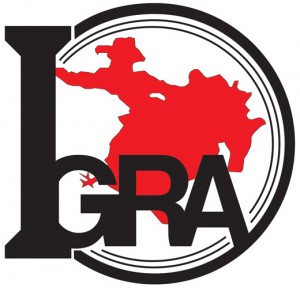International Gay Rodeo Association (IGRA) Holds the World Gay Rodeo Finals in Ft. Worth
The Houston Livestock Show and Rodeo is easily one of this city’s premiere events every year, and a large magnet for many cowboy-loving adults and their carnival-ride-obsessed children. While Houston’s fried Oreos and mutton-busting events are enough to entertain even the least-enthused audience members, it’s hard to compare a “traditional” rodeo to the wildly diverse and just as professional gay rodeos happening throughout the country.
On October 7–9, the International Gay Rodeo Association (IGRA) will hold the World Gay Rodeo Finals at the Watt Arena in Ft. Worth. Culminating a year’s worth of gay rodeo competitions throughout the country, the best male and female competitors will compete for the prized belt buckles and saddles given to the winners.
“When it gets down to the differences between our rodeo and what’s considered a traditional rodeo, first off, men and women compete in all events. Men compete against men, and women against women, but they’re able to compete in all events. So we have women bull-riders and women bronco riders, and we have men running barrels and running poles,” says Ken Pool, a former gay rodeo competitor and current employee of the IGRA. “We kind of blur those gender roles a little bit.”
While not as large as a traditional rodeo, the Ft. Worth event is crammed with some of the best rodeo performers in the entire country, coming from 13 gay rodeos that were held throughout the year.
Contestants this year will compete in bull riding, bareback bronc riding, junior bull riding, chute dogging, roping events (such as team roping and mounted break-away roping), and speed events such as barrel racing and pole bending. Even as a niche group, the gay rodeo finals typically draw in thousands of participants and are often second only to Pride events as the largest gay gatherings in a city.
“We allow people to compete as they self-identify. If someone is in the middle of a transgender situation and identifies as a woman, then they compete as a woman. We also welcome a lot of straight people,” Pool said. “There’s no litmus test. We welcome everyone. There are a lot more similarities than there are differences between the gay rodeo and professional rodeos.”
The gay rodeo got its official start in 1976. Phil Ragsdale, known back then as the “Court Emperor” of Reno, Nevada, held the first gay rodeo as a way to raise money for the Muscular Dystrophy Association.
As it grew over the years, rodeo fans and participants began forming their own associations, first in Colorado, and then in Texas, California, and Arizona. In 1985, these groups united to create the larger International Gay Rodeo Association to more easily plan each year’s events. There are currently 20 associations across the country, including a Texas Gay Rodeo Association with headquarters in Austin.
Of course, a gay rodeo couldn’t be gay without offering spectators plenty of camp in addition to the thrills and professionalism found in the rodeo competitions. The wildly popular steer decorating and goat dressing are exactly what they sound like: a two-person team must either put ribbons on a steer’s tail or dress up a goat with jockey-style underwear. A third camp event combines the time-honored tradition of drag with a steer ride.
“There are categories of events called camp events. They’re real crowd-pleasers with a lot of entertainment value,” Pool said. “There’s one called the wild drag race. It’s a three-person team—one of the people is actually in drag, and the other two help them. The drag queen has to
get on a steer and get across a line. It’s a lot of fun to see the drag queen thrown around a bit.”
And what rodeo is complete without line dancing, two-stepping, and all other forms of boot-scoot boogying? The International Gay Rodeo certainly isn’t, and it has an avid following of dancers to prove it.
“Friday night we have a meet-the-contestants party, and then we have a dance. Dancing is a big part of the International Gay Rodeo. We have dance competitions and allow those people interested in that to compete with each other,” Pool said.
“We’re a very competitive group,” he added with a laugh.
The gay rodeo’s fervent dance scene has its origins in dance troupes that would perform for rodeo crowds after the day’s events. Now, competitions are held throughout the year in various chapters, including the IGRA’s annual dance competition. Next year’s event, held in January, is already being planned at the IGRA’s university in St. Louis.
In addition to the dancing, the camp events, and the actual competition, IGRA has a royalty competition where a drag queen and king compete at the state level with their local gay rodeo association before moving on to the international final round.
“They sort of become our ambassadors,” Pool said. “They entertain, do public relations, and fundraising. The IGRA works very hard to make sure our organization is supporting our communities.”
The IGRA also gives back by training anyone who wants to star in a future gay rodeo. Smaller amateur training courses are held in chapters throughout the country.
If only Heath Ledger and Jake Gyllenhaal’s star-crossed lovers in Brokeback Mountain had waited a few years and made their way to the first gay rodeo, their sad tale might have ended differently. A melting pot of all forms of gender expression, sexuality, and skill levels, the gay rodeo is an inviting event that offers a great sense of community not to be found at any other rodeo or fair.
“We’re considered an amateur rodeo association, but I will tell you that the level of competition, especially amongst the horse events, is world-class. We’re really fortunate to have seen some really talented horse people who actually do this for a living and are able to come here, have camaraderie, and compete,” Pool said. “There are some beautiful animals, and some beautiful athletes performing.”











Comments